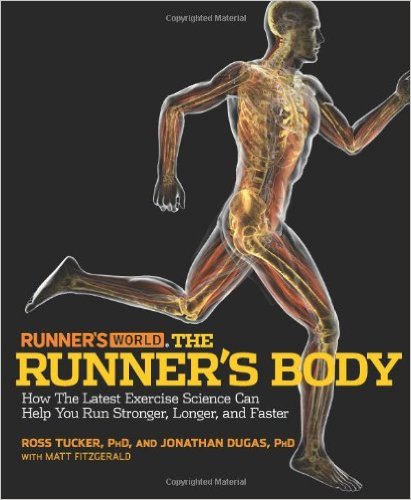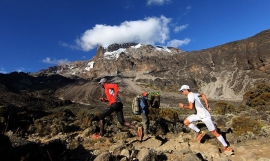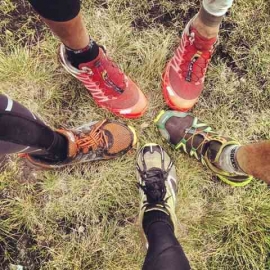关于作者Matt Fitzgerald更多资料见:
Matt Fitzgerald_运动营养学专家_Runner's World书籍作者-跑步作家-人物百科-跑步百科
//www.nduoke.com//www.nduoke.com/renwubaike/matt-fitzgerald
Matt Fitzgerald出版的十多本畅销运动营养、跑步饮食书籍合集见:
Matt Fitzgerald(Runner's World运动营养学专家)书籍合集(附PDF电子书网盘下载地址)
//www.nduoke.com//www.nduoke.com/running-books/matt-fitzgerald-books
《Runner's World The Runner's Body: How the Latest Exercise Science Can Help You Run Stronger, Longer, and Faster》简介:
Every day scientists learn more about how the body adapts to the stress of running―and how various body systems contribute to running performance. Leading the charge is a fresh generation of brilliant young exercise physiologists including Ross Tucker and Jonathan Dugas, whose work has demolished many long-standing beliefs about running. Now Tucker and Dugas, whose blog, Science of Sport, has already created a devoted readership, join with esteemed fitness author Matt Fitzgerald to provide a captivating tour of the human body from the runner's perspective. Focusing on how runners at all levels can improve their health and performance, Runner's World The Runner's Body offers in a friendly, accessible tone, the newest, most surprising, and most helpful scientific discoveries about every aspect of the sport―from how best to nourish the runner's body to safe and legal ways to increase oxygen delivery to the muscles. Full of surprising facts, practical sidebars, and graphical elements, The Runner's Body is a must-have resource for anyone who wants to become a better―and healthier―runner.
About the Author
ROSS TUCKER, PHD, serves as scientific editor of Runner's World South Africa, a consultant technical expert with Adidas South Africa, and editor of Health 24, South Africa's largest fitness- and health-related Web site. Tucker, a competitive runner himself, lives in Cape Town, South Africa.
JONATHAN DUGAS, PHD, holds a post-doctoral fellowship with the University of Chicago. He is the cocreator, with his colleague Ross Tucker, of the popular Science of Sport blog. A qualified USA Cycling coach, he lives in Chicago.
MATT FITZGERALD is a prolific health and fitness journalist. He writes regularly for such national publications as Men's Fitness, Men's Health, Runner's World, and Triathlete. With nine books to his credit, he also creates interactive training programs for runners and triathletes and leads clinics at triathlon and running events throughout the U.S. He lives in Northern California.
《Runner's World The Runner's Body: How the Latest Exercise Science Can Help You Run Stronger, Longer, and Faster》读者评论:
I think this book presents a lot of good information, but it shockingly lacks references or a bibliography. The whole premise of the book is that the authors - 2 of whom have PhD's - are reviewing current studies on running. But they don't cite the studies, many of which I would like to take a peek at. How can two guys with doctorates write something and not provide their references? In college we would be accused of academic misconduct for doing that.
Assuming the information is accurate, I think this is a good review. It's a little wordy and blathers on in some places, as if trying to add some meat. For the price, it's worth the read. There are a couple of annoying editorial mistakes, like missing graphics, but that's sort of forgivable.
A fantastic resource for the science-oriented runner. Lies strongly toward the left on the spectrum between peer-reviewed journal and popular press. No bibliography and no citations are a definite weakness. The material is presented in a logical fashion and is readable for someone who isn't accustomed to the peer-reviewed journal format (most people). Challenges many of our cherished beliefs regarding proper training, nutrition, recovery, etc. If you're looking for a day- by-day training guide this isn't it, but if you want to know what the current research shows about training principals, this is for you.
Are you a runner who wants to be enlightened? Then pick up this book, which challenges conventional wisdom in many areas including training, diet, fatigue, and injuries. I have been running for three years and trying to move up a level. This has helped me understand many things about my body and its adaptation to running. I've already seen my times improve. One point I will make is that the information may be overwhelming to a beginning runner or a non-runner who is considering the sport; however, for anyone who has been running seriously even for a few years, you will learn a lot and should be able to make some adjustments right away. The only people who may not be too keen on it are the makers of nutritional supplements and some sports drinks, whose effectiveness the book debunks. Another point is that I read this book on the Kindle, and some of the charts don't reproduce as well on its screen. I suspect that the paper version would alleviate that problem.
This book was very good overall. It told me a lot of things that to which I wanted th answer and hadn't be able to find all in one place.
1. NO! muscle soreness is not caused by lactic acid burn. It is caused by microscopic tears in the muscle fiber!
2. There was enough repetition to know which points the authors were underlining. When reading books that have so much information, it is always good to have some things repeated (they can get lost in the way of getting through the whole book).
3. There was just enough technical information to give you the background necessary without turning it into a Biology text. It appears that their journalist co-author (Matt Fitzgerald) helped them to cut down some of the non-essential information. This book was not the least bit bloated.
4. This book could be read in any order if you wanted to skip to the parts that you wanted to read most.
5. There were very useful diagrams of atypical stretches that most of us don't do.
Problems:
1. As others have noted, this book does not have a bibliography-- and that would have been useful if one wanted to look at the abstracts of some of these articles to check the conclusions and sample sizes for oneself.
2. There were lots of good stretching diagrams, but some of the stretches that they described in the text would have been a lot easier to visualize if they had just included a photo. Why not have just been consistent and put in photos for all the stretches described? In this case, a photo really *would* have been worth 1,000 words! Better yet, a *whole section* of photos on stretching (given its importance in running).
3. I could have done with a section on the racial differences between runners. They had a section on East African distance runners, but they could have expanded that section and answered some things about the differing bone profiles of the races.
I broke one of my cardinal rules and bought this book new, but it was much worth it. I also see why the asking price was so high: There was enough good information in it to justify that price.
更多runner's world 杂志与书籍 见://www.nduoke.com//www.nduoke.com/running-books/runners-world
更多跑步书籍见://www.nduoke.com//www.nduoke.com/running-books
跑步书籍下载见://www.nduoke.com//www.nduoke.com/shujixiazai
跑步书籍百科见://www.nduoke.com//www.nduoke.com/shujibaike




